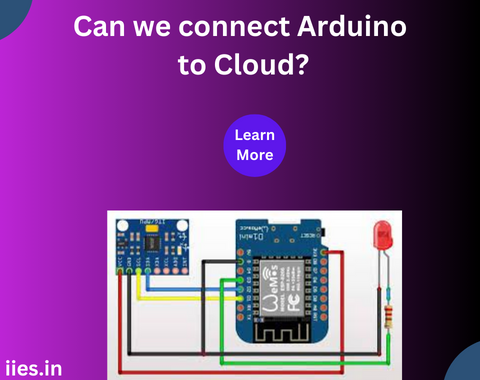
In the era of the Internet of Things (IoT), where devices are becoming increasingly interconnected and intelligent, the ability to connect microcontrollers like Arduino to the cloud opens up a world of opportunities. Arduino, with its simplicity and versatility, has long been a favorite among hobbyists, students, and professionals for prototyping electronic projects. However, by integrating it with cloud services, its capabilities expand exponentially, enabling remote monitoring, data analysis, and control from anywhere in the world. In this article, we delve into the intricacies of connecting Arduino to the cloud, exploring its potential applications, and the tools and techniques required to accomplish this feat.
At its core, connecting Arduino to the cloud involves establishing a communication channel between the microcontroller and cloud-based servers. This allows data collected by Arduino sensors to be transmitted to the cloud for storage, analysis, and visualization, while also enabling remote commands to be sent back to the device for control purposes.
1. Arduino Board: The hardware platform responsible for gathering sensor data, executing instructions, and interfacing with other electronic components.
2. Internet Connectivity Module: In order to connect Arduino to the cloud, it needs a means of accessing the internet. This can be achieved through modules like Ethernet shields, Wi-Fi modules, or GSM/GPRS shields, depending on the project requirements and available resources.
3. Cloud Service Provider: A cloud platform where the data collected by Arduino is stored and processed. Popular choices include Amazon Web Services (AWS), Google Cloud Platform (GCP), Microsoft Azure, and many others, each offering a range of services tailored to IoT applications.
Techniques for Connecting Arduino to the Cloud:
Several methods exist for establishing communication between Arduino and the cloud, each with its own advantages and challenges. Some common techniques include:
1. Direct HTTP/HTTPS Communication: In this approach, Arduino sends HTTP or HTTPS requests directly to a web server hosted on the cloud platform. This method is relatively simple to implement but may require handling issues such as security, reliability, and scalability on the server side.
2. MQTT (Message Queuing Telemetry Transport): MQTT is a lightweight messaging protocol designed for IoT applications. Arduino devices can publish data to an MQTT broker hosted in the cloud, which then distributes the data to subscribers as needed. This method is efficient in terms of bandwidth and is well-suited for scenarios requiring real-time data transmission.
3. WebSocket Communication: WebSockets provide a persistent, bidirectional communication channel between the Arduino device and a cloud-based WebSocket server. This enables low-latency, interactive data exchange, making it ideal for applications like remote control and monitoring.
4. IoT Platforms and Middleware: Several IoT platforms and middleware solutions are available that abstract away much of the complexity involved in connecting Arduino to the cloud. These platforms typically offer features such as device management, data visualization, analytics, and integration with third-party services, streamlining the development process.
Applications of Arduino-Cloud Integration:
The ability to connect Arduino to the cloud opens up a myriad of practical applications across various domains:
1. Smart Home Automation: Arduino-based sensors and actuators can be connected to the cloud to enable remote monitoring and control of home appliances, lighting, security systems, and environmental conditions.
2. Industrial Monitoring and Control: In industrial settings, Arduino devices can collect data from sensors deployed on machinery and equipment, sending this data to the cloud for predictive maintenance, process optimization, and real-time monitoring of production metrics.
3. Environmental Monitoring: Arduino sensors can be deployed in the field to monitor parameters such as temperature, humidity, air quality, and soil moisture. By transmitting this data to the cloud, researchers and environmentalists can gain valuable insights into climate patterns, pollution levels, and ecological health.
4. Healthcare and Wearable Devices: Arduino-based wearable devices equipped with sensors for monitoring vital signs such as heart rate, blood pressure, and body temperature can transmit this data to cloud-based healthcare platforms for remote patient monitoring and medical diagnostics.
5. Smart Agriculture: In agriculture, Arduino sensors can be used to monitor soil moisture, temperature, and humidity, enabling precision irrigation and crop management. Data collected from the field can be analyzed in the cloud to optimize agricultural practices and increase crop yields.
Challenges and Considerations:
While the prospect of connecting Arduino to the cloud holds immense promise, it also presents certain challenges and considerations:
1. Power Consumption: Internet connectivity and data transmission can significantly impact the power consumption of Arduino-based devices, especially in battery-powered applications. Optimizing power usage and implementing sleep modes are crucial for extending battery life.
2. Security: Ensuring the security of data transmitted between Arduino devices and the cloud is paramount, particularly when dealing with sensitive information. Implementing encryption, authentication mechanisms, and secure communication protocols is essential to mitigate the risk of unauthorized access and data breaches.
3. Scalability: As the number of connected devices grows, managing and scaling the infrastructure to handle increased data volume and traffic becomes increasingly complex. Designing a scalable architecture that can accommodate future growth is vital for long-term success.
The ability to connect Arduino to the cloud represents a significant milestone in the evolution of IoT technology, unlocking a wealth of possibilities for innovation and creativity. By harnessing the power of cloud computing, Arduino-based devices can transcend their traditional limitations, enabling real-time monitoring, data analysis, and remote control across diverse application domains. While challenges such as power consumption, security, scalability, and cost must be addressed, the potential benefits far outweigh the obstacles, making Arduino-cloud integration a compelling avenue for future exploration and development. As the IoT ecosystem continues to evolve, the synergy between Arduino and the cloud promises to revolutionize how we interact with the digital world, ushering in a new era of connected devices and intelligent systems.
Indian Institute of Embedded Systems – IIES